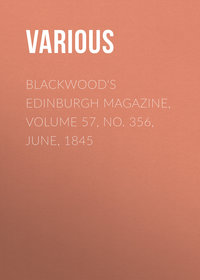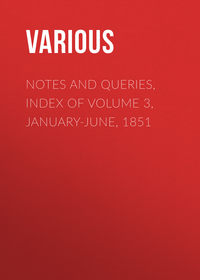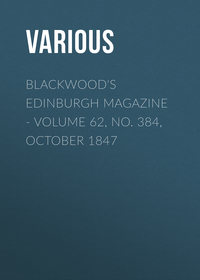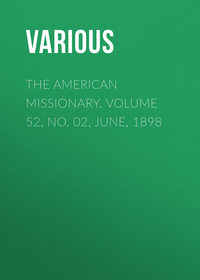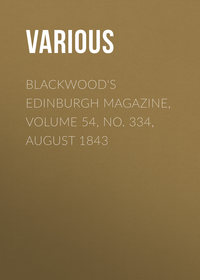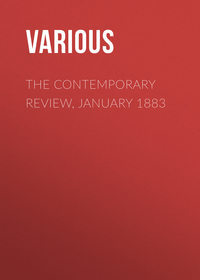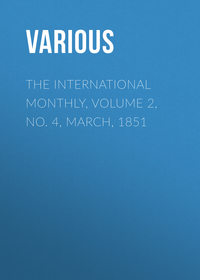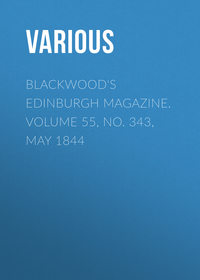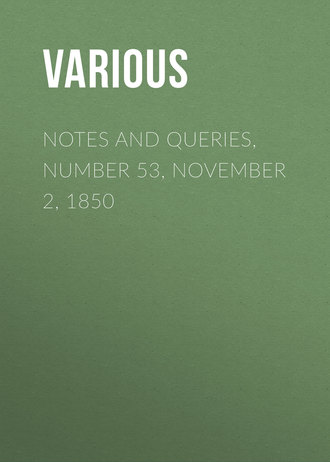 полная версия
полная версияNotes and Queries, Number 53, November 2, 1850
The Mrs. Bilderdijk who translated Roderick, was, according to Southey, the second wife of her husband. How did JANUS DOUSA learn that her maiden name was Schweickhardt?
G.J. DE WILDE.Noli me tangere (Vol. ii., p. 153.).—In addition to the list of artists given by J.Z.P. (p. 253.), BR. will find that the subject has also been treated by—
Duccio, in the Duomo at Siena.
Taddeo Gaddi, Rinnucini Chapel.
Titian, Mr. Roger's Collection.
Rembrandt, Queen's Gallery.
Barroccio. An altar piece which came to England with the Duke of Lucca's paintings, but I cannot say where it is now; it is well known by the engraving from it of Raphael Morgen.
B.N.C.Chimney Money (Vol. ii., pp. 120. 174. 269. 344.).—There is a church at Northampton upon which is an inscription recording that the expense of repairing it was defrayed by a grant of chimney money for, I believe, seven years, temp. Charles II.
There is also a tombstone in Folkestone churchyard curiously commemorative of this tax. The inscription runs thus—
"In memory of
Rebecca Rogers,
who died August 29. 1688,
Aged 44 years.
"A house she hath, it's made of such good fashion,The tenant ne'er shall pay for reparation,Nor will her landlord ever raise her rent,Or turn her out of doors for non-payment;From chimney money, too, this cell is free,To such a house, who would not tenant be."E.B. PRICE.Passage from Burke (Vol. ii., p. 359.).—Q.(2) will find the passage he refers to in Prior's Life of Burke, vol. i. p. 39. It is extracted from a letter addressed by Burke to his old schoolfellow Matthew Smith, describing his first impressions on viewing Westminster Abbey, and other objects in the metropolis. Mr. Prior deserves our best thanks for giving us a letter so deeply interesting, and so characteristic of the gifted writer, then barely of age.
I.H.M.Bath.
Nicholas Assheton's Journal (Vol. ii., pp. 331-2.).—If T.T. WILKINSON will turn to pp. 45, 6, 7, of this very amusing journal, published by the Chetham Society (vol. xiv., 1848), he will find some account of the Revels introduced before James the First at Hoghton Tower, in the copious notes of the editor, the Rev. F.R. Raines, M.A., F.S.A., elucidating the origin and history of these "coarse and indecorous" dances—the Huckler, Tom Bedlo, and the Cowp Justice of Peace.
J.G.Manchester.
Scotch Prisoners, 1651 (Vol. ii., pp. 297. 350.).—Heath's Chronicle (p. 301. edit. 1676) briefly notices these unhappy men, "driven like a herd of swine, through Westminster to Tuthill Fields, and there sold to several merchants, and sent in to the Barbadoes."
The most graphic account, however, is given in Another Victory in Lancashire, &c., 4to. 1651, from which the parts possessing local interest were extracted by me in the Civil War Tracts of Lancashire, printed by the Chetham Society, with references to the other matters noticed, namely, Cromwell's entry into London, and the arrival of the four thousand "Scots, Highlands, or Redshanks."
These lay on Hampstead Heath, and were thence guarded through Highgate, and behind Islington to Kingsland and Mile End Green, receiving charity as they went, and having "a cart load or two of biskett behind them." Thence they proceeded by Aldgate, through Cheapside, Fleetstreet, and the Strand, and on through Westminster.
"Many of them brought their wives and berns in with them, yet were many of our scotified citizens so pitifull unto them, that as they passed through the city, they made them, though prisoners at mercy, masters of more money and good white bread than some of them ever see in their lives. They marched this night [Saturday, Sept. 13.] into Tuttle Fields. Some Irishmen are among them, but most of them are habited after that fashion."
The contemporary journals in the British Museum would probably state some epidemic which may have caused the mortality that followed.
GEO. ORMERODSedbury Park, Clepstow.
Long Friday (Vol. ii., p. 323.).—T.E.L.L. is not correct in his supposition that "Long Friday" is the same as "Great Friday". In Danish, Good Friday is Langfredag; in Swedish, Längfredag. I have always understood the epithet had reference to the length of the services.
COLL. ROYAL SOC.The Bradshaw Family (Vol. ii., p. 356.).—The president of the pretended high court of justice, a Cheshire man, had no connexion with Haigh Hall, in Lancashire. E.C.G. may satisfy himself by referring to Mr. Ormerod's History of Cheshire (vol. iii. p. 408.) for some valuable information respecting the regicide and his family, and to Wotton's Baronetage (vol. iii. P. 2. p. 655.) for the descent of the loyal race of Bradshaigh.
J.H.M.Bath.
Julin, the drowned City (Vol. ii., pp. 230. 282.).—I am sorry I did not state more clearly the inquiry respecting the fate of Julin, which DR. BELL has been so good as to notice. This is partly the printer's fault. I spoke of the drowned, not the doomed city.
The drowning was what I desired some account of. "A flourishing emporium of commerce", extant in 1072, and now surviving only in tradition, and in "records" of ships wrecked on its "submerged ruins," does not sink into the ocean without exciting wonder and pity. I knew of the tradition, and presumed there was some probability of the existence of a legend (legendum, something to be read) describing a catastrophe that must have been widely heard of when it happened.
This I conjectured might be found in Adam of Bremen; to whose mention of Julin DR. BELL referred. But it seems that in his time the city was still existing, and flourishing ("urbs locuples").
The "excidium civitatis," if the Veneta of Helmold were Julin, must have taken place, therefore, between 1072 and 1184, when the latter account was written. If Veneta was Julin, and "aquarum æstu absorpta," there must, I suppose, be some account of this great calamity: and as I have seen in modern German works allusions to the drowning of the great city, and to the ruins still visible at times under water, I hoped to find out the where of its site, and the when of its destruction—as great cities do not often sink into the waves, like exhalations, without some report of their fate.
V. Belgravia.Dodsley's Poems (Vol. ii., pp. 264. 343).—THE HERMIT OF HOLYPORT is informed that the first edition of Dodsley's Collection of Poems, by several Hands, was published in 1748, 3 vols. 12mo. A fourth volume was added in 1749, containing pieces by Collins, Garrick, Lyttelton, Pope, Tickell, Thomson, &c. Those by Garrick and Lyttelton are anonymous. The four volumes were reprinted uniformly in 1755. The fifth and sixth were added in 1758.
AMICUS CURIÆ.Shunamitis Poema (Vol. ii., p. 326.).—The titlepage to the volume of poems inquired after by E.D. is as follows:
"Latin and English Poems, by a Gentleman of Trinity College, Oxford.
'Nec lusisse pudet sed non incidere ludum.' HOR.
London: printed for L. Bathurst over against St. Dunstan's Church, in Fleet Street, MDCCXLI."
I know not the author; but I suspect either that the title of an Oxford man was assumed by a Cantab, who might fairly wish not to be suspected as the author of several of the poems; or that the author, having been rusticated at Cambridge, vide at p. 84. the ode "Ad Thomam G." (whom I take to be Thomas Gilbert of Peterhouse), transferred himself and his somewhat licentious muse to Oxford.
COLL. ROYAL SOC.Jeremy Taylor's Works (Vol. ii., p. 271.).—It seems desirable that an advance should occasionally be made in editing, beyond the mere verification of authorities, in seeing, that is, whether the passages cited are applicable to the point in hand, and properly apprehended. Bp. Taylor, in his Liberty of Prophecying, sect. vi., for instance, seems incorrect in stating that Leo I., bishop of Rome, rejected the Council of Chalcedon; whereas his reproofs are directed against Anatolias, bishop of Constantinople, an unwelcome aspirant to ecclesiastical supremacy. (See Concilia Studio Labbei, tom. iv., col. 844, &c.)
A passage frown Jerome's Epistle to Evangelus is often quoted in works on church government, as equalising, or nearly so, the office of bishop and presbyter; but the drift of the argument seems to be, to show that the site of a bishop's see, be it great or small, important or otherwise, does not affect the episcopal office. Some readers will perhaps offer an opinion on these two questions.
NOVUS.Ductor Dubitantium.—The Judge alluded to by Jeremy Taylor in the passage quoted by A.T. (Vol. ii., p. 325.), was Chief-Justice Richardson; but the place where the outrage was committed was not Ludlow, as stated by the eloquent divine, but Salisbury, as appears from the following marginal note in Dyer's Reports, p. 1886—a curious specimen of the legal phraseology of the period:—
"Richardson, C.J. de C.B. at Assizes at Salisbury in Summer 1631 fuit assault per Prisoner la condemne pur Felony; que puis son condemnation ject un Brickbat a le dit Justice, que narrowly mist. Et pur ceo immediately fuit Indictment drawn pur Noy envers le Prisoner, et son dexter manus ampute et fixe al Gibbet, sur que luy mesme immediatement hange in presence de Court."
EDWARD FOSS.Aërostation (Vol. ii., p. 317.).—The account published by Lunardi of his aërial voyage, alluded to by M., is, in the copy I have seen, entitled
"An Account of the First Aërial Voyage in Britain, in a series of letters to his guardian, the Chevalier Gherardo Compagni, written under the impressions of the various events that affected the undertaking, by Vicent Lunardi, Esq., Secretary to the Neapolitan Ambassador. 'A non esse nec fuisse non datur argumentum ad non posse.' Second edition, London: printed for the Author, and sold at the Panther; also by the Publisher J. Bell, at the British Library, Strand, and at Mr. Molini's, Woodstock Street, MDCCLXXXIV."
The book contains printed copies of the depositions of witnesses who beheld Lunardi's descent; and Mr. Baker, who, as a magistrate, took those depositions on oath, to establish what he thought so wonderful a fact, erected on the spot where the balloon descended, in a field near Colliers End, in the parish of Standon, Herts, on the left of the high road from London to Cambridge, a stone with the following inscription on a copper plate. It is still legible, though somewhat defaced. It is engraved in lines of unequal length, but to save your space I have not adhered to those divisions.
"Let posterity know, and knowing, be astonished, that on the fifteenth day of September, 1784, Vincent Lunardi of Lucca, in Tuscany, the first aërial traveller in Britain, mounting from the Artillery Ground in London, traversing the regions of the air for two hours and fifteen minutes, in this spot revisited the earth. On this rude monument for ages be recorded, that wondrous enterprise, successfully achieved by the powers of chemistry and the fortitude of man, that improvement in science, which the great Author of all knowledge, patronising by His providence the inventions of mankind, hath graciously permitted to their benefit and His own eternal glory."
COLL. ROYAL SOC.Gwyn's London and Westminster (Vol. ii., p. 297.).—A reference to Mr. Croker's Boswell (last edit. 1847, p. 181.) may best satisfy § N. "Gwyn," says Mr. Croker, "proposed the principle, and in many instances the details, of the most important improvements which have been made in the metropolis in our day." Was this copied into the Literary Gazette?
Mr. Sydney Smirke speaks favourably of Gwyn's favourite project, "the formation of a permanent Board or Commission for superintending and controlling the architectural embellishments of London." (Suggestions, &c., 8vo. 1834, p. 23.)
J.H.M.Bath.
Gwyn's London and Westminster (Vol. ii., p. 297.).—Under this head § N. inquires, "Will you permit me, through your useful publication, to solicit information of the number and date of the Literary Gazette which recalled public attention to this very remarkable fact:" namely, that stated by Mr. Thomas Hunt, in his Exemplars of Tudor Architecture (Longmans, 1830), to the effect that the Literary Gazette had referred to the work entitled London and Westminster Improved, by John Gwynn. London, 1766, 4to., as having "pointed out almost all the designs for the improvement of London which have been devised by the civil and military architects of the present day."
In answer to the above, your correspondent will find two articles in the Literary Gazette on this interesting subject; the first in No. 473., Feb. 11. 1826, in which it is mentioned that Mr. Gwynn, founding himself in some degree upon the plan of Sir C. Wren, proposed
"To carry a street from Piccadilly through Coventry Street, Sydney's Alley, Leicester Fields, Cranbourn Alley, and so to Long Acre, Queen Street, and Lincolns Inn Fields, and thus afford an easy access to Holborn; he also recommends the widening the Strand in its narrow parts," &c.
I need hardly notice that by the removal of Exeter Change, the alterations near Charing Cross, and the more recent openings from Coventry Street, along the line suggested by Mr. Gwynn, his designs have been so far carried out.
The second paper in the Literary Gazette was rather a long one, No. 532., March 31. 1827. In it Mr. Gwynn's publication is analysed, and all the leading particulars bearing on the "old novelties of our modern improvements" are brought to light.
The whole is worth your reprinting, and at your service, if you will send a copyist to the Literary Gazette office to inspect the volume for 1827.
W.J., ED."Regis ad Exemplum totus componitur Orbis" (Vol. ii., p. 267.).—This hexameter verse, which occurs in collections of Latin apophthegms, is not to be found in this form, in any classical author. It has been converted into a single proverbial verse, from the following passage of Claudian:
"Componitur orbisRegis ad exemplum: nec sic inflictere sensusHumanos edicta valent, ut vita regentis."De IV. Consul. Honor., 299.L.St. Uncumber (Vol. ii., pp. 286. 342.).—Sir Thomas More details in his Dialoge, with his usual quaintness, the attributes and merits of many saints, male and female, highly esteemed in his day, and, amongst others, makes special mention of St. Uncumber, whose proper name, it appears, was Wylgeforte. Of these saints he says—
"Some serve for the eye onely, and some for a sore breast. St. Germayne onely for children, and yet will he not ones loke at them, but if the mother bring with them a white lofe and a pot of good ale: and yet is he wiser than St. Wylgeforte, for she, good soule, is, as they say, served and contented with otys. Whereof I cannot perceive the reason, but if it be bycause she sholde provyde an horse for an evil housebonde to ride to the Devyll upon; for that is the thing that she is so sought for, as they say. In so much that women hath therefore chaunged her name, and in stede of St. Wylgeforte call her St. Uncumber, bycause they reken that for a pecke of otys she will not fayle to uncumber theym of theyr housbondys."—(Quoted in Southey's Colloquies, vol. i. p. 414.)
St. Wylgeforte is the female saint whom the Jesuit Sautel has celebrated (in his Annus Sacer Poeticus) for her beard—a mark of Divine favour bestowed upon her in answer to her prayers. She was a beautiful girl, who wished to lead a single life, and that she might be suffered to do so free from importunity, she prayed earnestly to be rendered disagreeable to look upon, either by wrinkles, a hump on the back, or in any other efficacious way. Accordingly the beard was given her; and it is satisfactory to know that it had the desired effect to the fullest extent of her wishes. (Vid. Southey's Omniana, vol. ii. p. 54., where Sautel's lines are quoted.)
J.M.B.West (James), President of Royal Society (Vol. ii., p. 289.).—T.S.D. states there "has certainly never been a president or even a secretary of the Royal Society, of the name of James West." Your readers will remember that West is mentioned by Mr. Cunningham in his London, as having filled the former distinguished office: his statement, which T.S.D. thus contradicts, is perfectly correct.
Mr. West's election took place 30th of November, 1768, and he filled the chair until his death in July, 1772.
J.H.M.[Mr. Cooper, of Cambridge, J.G.N., and other correspondents, have called our attention to this oversight.]
MISCELLANEOUS
NOTES OF BOOKS, SALES, CATALOGUES, ETC
The idea of selecting from the Spectator those papers in which the refined taste of Addison, working on the more imaginative genius of Steele, has embodied that masterpiece of quiet thorough English humour which is exhibited in the portrait of Sir Roger de Coverley, is a most happy one,—so excellent indeed, and when done, it is so obviously well that it is done, that we can only wonder how it is, that, instead of having now to thank Messrs. Longman for the quaintly and beautifully got up volume entitled Sir Roger de Coverley. By the Spectator. The Notes and Illustrations by Mr. Henry Wills: the Engravings by Thompson, from Designs by Fred. Tayler,—as a literary novelty—such a selection has not been a stock book for the last century. Excellent, however, as is the idea of the present volume, it has been as judiciously carried out as happily conceived. Mr. Tayler's designs exhibit a refined humour perfectly congenial with his subject, and free from that tendency to caricature which is the prevailing fault of too many of the comic illustrators of the present day; while the pleasant gossiping notes of Mr. Wills furnish an abundance of chatty illustration of the scenes in which Sir Roger is placed, and the localities he visited, and so enable us to realise to ourselves, in every respect, Addison's admirable picture of the worthy knight, "in his habit as he lived." May we add that, on looking through these amusing notes, we were much gratified to find Mr. Wills, in his illustration of the passage, "his great-grandfather was inventor of that famous country-dance called after him," speaking of "the real sponsor to the joyous conclusion of every ball" as having "only been recently revealed, after the most vigilant research," since that revelation, with other information contained in the same note, was procured by that gentleman through the medium of "NOTES AND QUERIES."
Messrs. Sotheby and Wilkinson are now selling the last portion of the Miscellaneous Stock of the late Mr. Thomas Rodd. This sale, which will occupy eleven days, will close on Friday next: and on Saturday they will sell the last portion of Mr. Rodd's, books, which will consist entirely of works relating to Ireland, including several of great curiosity and rarity.
Messrs. Puttick and Simpson will sell on Monday next a Collection of Books from the library of the late well-known and able antiquary, Dr. Bromet, together with his Bookcases, Drawing Materials, &c.
We have received the following Catalogues:—W. Brown's (No. 130. and 131. Old Street) List of English and Foreign Theological Books; W. Nield's (46. Burlington Arcade) Catalogue, No. 4., of very Cheap Books; W. Pedder's (18. Holywell Street) Catalogue Part IX., for 1850, of Books Ancient and Modern; J. Rowwell's (28. Great Queen Street, Lincoln's Inn) Catalogue, No 39., of a Select Collection of Second-hand Books; W. L. Lincoln's (Cheltenham House, Westminster Road) Sixty-second Catalogue of English, Foreign, Classical, and Miscellaneous Books.
BOOKS AND ODD VOLUMES WANTED TO PURCHASE
T. NAOGEONGUS—REGNUM PAPISTICUM. 8vo. 1553.
BARNABE GOOGE'S POPISH KINGDOM. 4to. 1570.
Odd VolumesBERRY'S HERALDRY, 9 Vols. Supplement.
SHAKSPEARE (Whittingham's Chiswick Edition), Vol. IV. 1814.
Letters, stating particulars and lowest price, carriage free, to be sent to MR. BELL, Publisher of "NOTES AND QUERIES," 186. Fleer Street.
NOTICES TO CORRESPONDENTS
As we again propose this week to circulate a large number of copies of "NOTES AND QUERIES" among members of the different provincial Literary Institutions, we venture, for the purpose of furthering the objects for which our paper has instituted, to repeat the following passage from our 52nd Number:—
It is obvious that the use of a paper like "NOTES AND QUERIES," bears a direct proportion to the extent of its circulation. What it aims at doing is, to reach the learning which lies scattered not only throughout every part of our own country but all over the literary world, and to bring it all to bear upon the pursuits of the scholar; to enable, in short, men of letters all over the world to give a helping hand to one another. To a certain extent, we have accomplished this end. Our last number contains communications not only from all parts of the metropolis, and from almost every country in England, but also from Scotland, Ireland, Holland, and even from Demerara. This looks well. It seems as if we were in a fair way to accomplish our design. But much yet remains to be done. We have recently been told of whole districts in England so benighted as never to have heard of "NOTES AND QUERIES;" and after an interesting question has been discussed for weeks in our columns, we are informed of some one who could have answered it immediately if he had seen it. So long as this is the case the advantage we may confer upon literature and literary men is necessarily imperfect. We do what we can to make known our existence through the customary modes of announcement, and we gratefully acknowledge the kind assistance and encouragement we derive from our brethren of the public press; but we would respectfully solicit the assistance of our friends upon this particular point. Our purpose is aided, and our usefulness increased by every introduction which can be given to our paper, either to a Book Club, to a Lending Library, or to any other channel of circulation amongst persons of inquiry and intelligence. By such introductions scholars help themselves as well as us, for there is no inquirer throughout the kingdom who is not occasionally able to throw light upon some of the multifarious objects which are discussed in our pages.
OXONIENSIS is thanked. His inclosure shall be made use of.
Volume the First of "NOTES AND QUERIES," with very copious Index, price 9s. 6d. bound in cloth, may still be had by order of all Booksellers.
The Monthly Part for October, being the Fifth of Vol. II., is also now ready, price 1s. 3d.
In the quotation from Jacob Behmen, p. 356., for "Gate of Deep "read "Gate of the Deep."
JOURNAL FRANCAIS, Publié à Londres.—Le COURRIER de l'EUROPE, fondé en 1840, paraissant le Samedi, donne dans chaque numéro les nouvelles de la semaine, les meilleurs articles de tous les journaux de Paris, la Semaine Dramatique par Th. Gautier ou J. Jauin, la Révue de Paris par Pierre Durand, et reproduit en entier les romans, nouvelles, etc., en vogue par les premiers écrivains de France. Prix 6d. London: JOSEPH THOMAS, 1. Finch Lane.
LIBRARY OF THE LATE WILLIAM BROMET, ESQ., M.D., F.S.A., BOOKCASES, ENGRAVINGS, DRAWING MATERIALS, &c.
PUTTICK AND SIMPSON, Auctioneers of Literary Property, will Sell by Auction at their Great Room, 191. Piccadilly, on Monday, Nov. 4th, the Library of the late Wm. Bromet, Esq., M.D., F.S.A., consisting of useful Works in General Literature, Topographical and Antiquarian, many of which contain additional illustrations, &c. Catalogues will be sent on application.
On the 1st of November, No. II., price 2s. 6d.
DETAILS of GOTHIC ARCHITECTURE, measured and drawn from existing Examples, by J.K. COLLING, Architect. The work is intended to illustrate those features which have not been given in Messrs. Brandon's "Analysis:" it will be uniform with that work, and also the "Gothic Ornaments." Each Number will contain five 4to. Plates, and be continued monthly.




